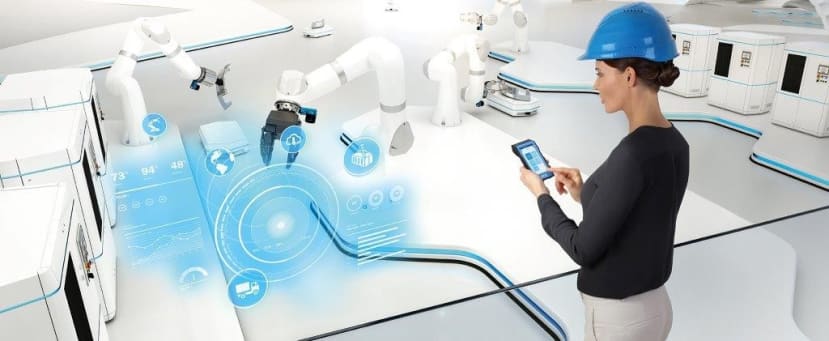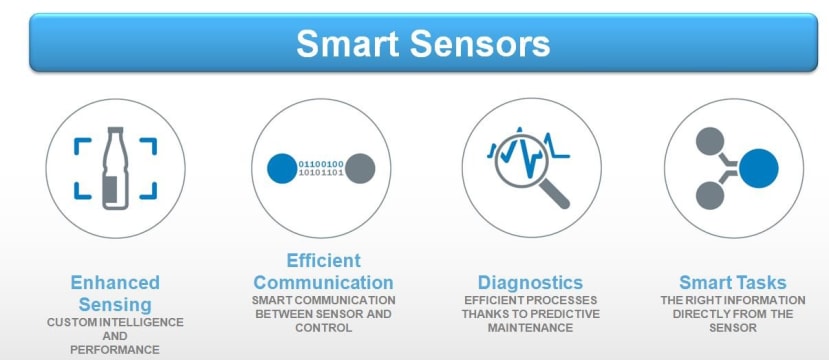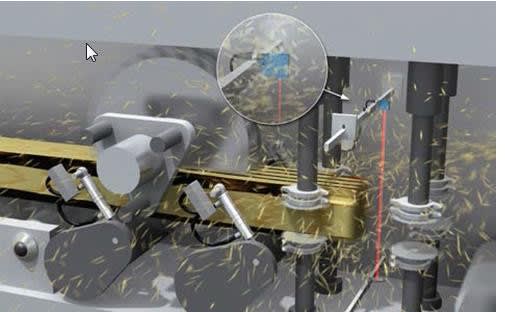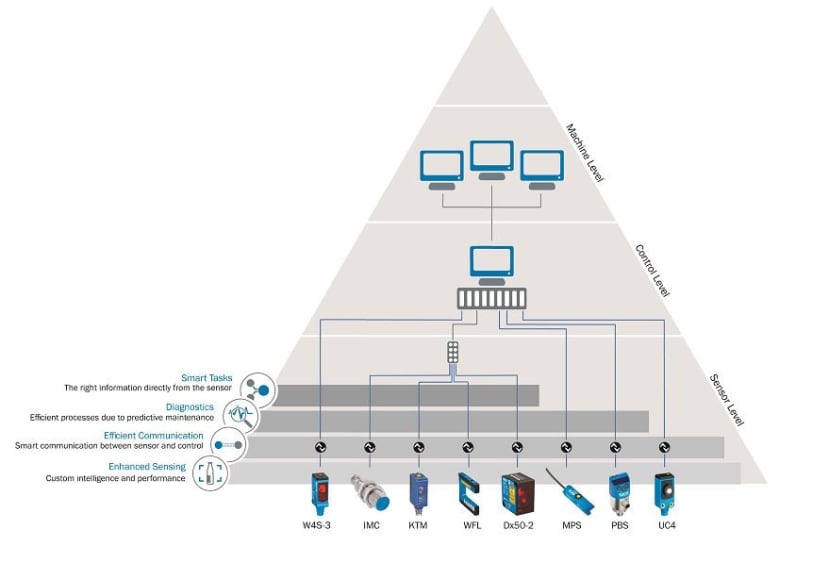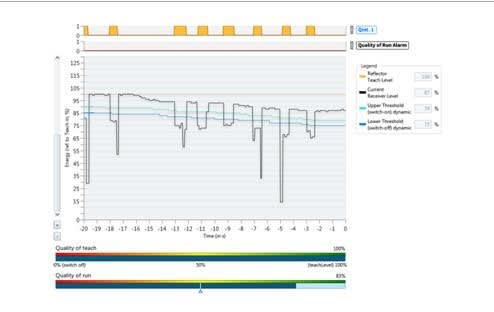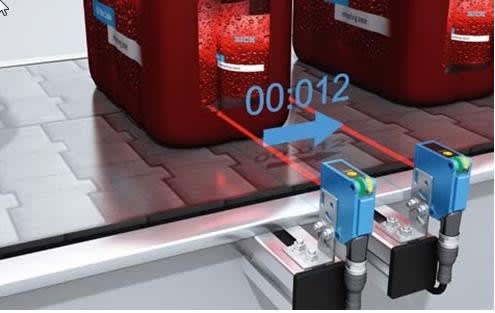Smart Sensors and IO Link delivers Industry 4.0
Follow articleHow do you feel about this article? Help us to provide better content for you.
Thank you! Your feedback has been received.
There was a problem submitting your feedback, please try again later.
What do you think of this article?
EVERYBODY’s talking about Industry 4.0 – but how many of us are really clear about what it means on a practical, day-to-day level? – and exactly what steps we should take now to ensure we have a “Smart Factory” in future?
By now, most of us probably have a vision of Industry 4.0 as a seamlessly-connected industrial world in which everything is integrated. Yet, this dream of universal connectivity and data sharing can seem very remote from the challenges we face every shift, delivering on machine availability, efficiency, throughput, and profitability.
So why, and where, is it relevant to us in practical terms and how do we future-proof our processes to be ready for it? I believe Industry 4.0 is already providing opportunities for us to deliver our objectives better – you just have to know where to look. Crucially, I see Industry 4.0 impacting much more at the shop-floor, micro level, rather than a global, macro one; only then does it all start to make more sense to me.
Perhaps, there’s something about being a sensor manufacturer that helps to inform this unique perspective: Sensors are on the front line of the fourth industrial revolution. Without their fundamental ability to monitor processes and collect reliable, high-quality data at the field level in the first place, the Smart Factory would just not exist.
The Four Industrial Revolutions
To begin with, let’s establish what we mean by the four industrial revolutions:
The first industrial revolution refers to the time when steam- and water-powered machines took over production, thanks to inventions like Newcomen’s steam engine in 1712. The second industrial revolution in the early 1900s introduced electric power and Henry Ford’s factory began the first forms of serial, mass production.
With Industry 3.0, in the late 1960s, came the digital revolution, when control and computer technology enabled full-scale industrial automation and we began to focus more specifically on perfecting consistent product quality and ensuring personnel safety in mass production.
Industry 4.0 is a term that was developed by the German government and first started to be defined at the Hannover Fair in 2013. Industry 4.0 connects physical systems to the internet and thereby enables high-value process data to be gathered and shared transparently from the system level right down to the sensor level.
Industry 4.0 brings with it the opportunity for distributed intelligent control, where a greater number of process decisions are made autonomously by devices at the field level. As a result, we not only have new levels of flexibility, remote monitoring and diagnostics, but we can also build in intelligent capability for sensors and systems to monitor, identify and respond automatically to situations on the shop floor in real time, for example, to change parameter settings on a product changeover.
The Four Pillars of Smart Sensors
So what exactly makes a Smart Sensor? What are the pre-requisites to adding real value to the whole communications pyramid and help to make factories “Smart”.
To help understand, we can think of sensors in terms of four key dimensions.
The Four Pillars of Smart Sensors
1. Enhanced Sensing – Simply Detect Any Object
Above all, Industry 4.0 underlines the need for better quality and quantity of data, intelligently communicated and used. So, it’s a pre-requisite that sensors must be able to first sense any object, no matter what the product, or how dirty, dusty or wet the conditions are.
Sensors are already well on the way to detecting and measuring any object, in virtually all industrial automation applications, from simple presence, proximity and distance devices to the in-built intelligence of Optical Character Verification and Recognition systems, and 3D machine vision.
Difficult-to-see objects, such as transparent, semi-transparent, uneven and highly-reflective objects like glass and plastics in bottling plants, or foil blisters used in pharmaceutical packaging, are no challenge for modern sensing technology from manufacturers like SICK.
The accuracy and consistency now achievable means production tasks can be controlled reliably to higher performance levels than ever before, with resultant benefits in low wastage, minimal line downtime and better quality control.
Compensation for disturbing environmental conditions
Two examples of sensors in the SICK range ideal for harsh environments.
The WTB12C-3P2432A71 BGS sensor - RS Stock NO. (111-3701) . Debounce can be set within the sensor over IO-Link to prevent false tripping in environments where small particles could trip the sensor.
The IMB12-04BPPVCOS inductive sensor - RS Stock No. (134-7807) . An inductive designed to detect metal in harsh environments
2.Efficient Communication - The Power of IO-Link
Just as important as the sensors themselves, is the power of IO-Link. IO-Link is a universal, open communications system that links sensors and actuators at the field level. It’s a bi-directional interface between the control system and the sensors or actuators, connected via an IO-Master.
Of course, IO-Link is not new; it has been tested and operated in machinery process control over several years. It has evolved into one of the most highly regarded two-way interfaces available today, passing data up to the machine level control system via standard unshielded three-wire cable which doesn’t require any extra time or cost to connect.
Before IO-Link, the information collected on machines was, in a sense, ‘trapped’ there, i.e. the data was not automatically visible and available to the control system. Then came IO-Link - and sensors were given a voice.
All the PLCs, computers, data networks and factory nets don’t mean a thing if they don’t have the quality data fed to them in real time from the sensors operating reliably on the shop floor. So, you could say that the combination of IO-Link and intelligent sensor technology has bridged the final gap that leads to transparent production. With IO-Link, sensors can complete the last leg of Industry 4.0.
Smart Sensors become the diligent data collectors and intelligent analysts that share their knowledge via IO-Link in real time.
So you can control and optimise your machines and processes and cut down on wiring and cabling nightmares. Smart Sensors deliver the data needed for upstream track and trace applications and they constantly monitor and facilitate consistent product quality.
Smart Sensors respond to all type of control commands. They can receive new settings in seconds, for example, to enable rapid product changeovers down to “Batch Size 1”. Replacement sensors are ‘plug and play’ because they can be configured instantly with pre-set parameters downloaded via IO-Link.
So, enhanced sensing technology combined with IO-Link are the first two pillars that make up the “essentials” of a Smart Sensor.
Now, there are two more key “pillars” that really start to demonstrate the enhanced potential and growing capabilities of Smart sensing technology.
Two examples in the SICK range where efficient communication can improve a customer’s process;
The WL9GC-3P2432A00 reflex sensor – RS Stock No. (134-7800) . Communicates its data to the PLC via IO-link and has internal logic and timer functions on board.
The PAC50-BCD Pneumatic Pressure sensor – RS Stock No. (100-0674) . Can be set up, monitored and controlled via IO-Link from your PLC
3. Diagnostics
With the control system fully connected to “see” the sensor, you have access to a full range of diagnostic capabilities that were not available previously. Is the sensor about to reach the end of its life? Does it need cleaning? Will it last until the next production changeover?
Through the combination of sensor self-monitoring and full transparency, production teams have much greater flexibility in monitoring their processes. They can adopt best practice approaches for effective condition monitoring and predictive maintenance.
Diagnostics and sensor self-monitoring
Two examples of SICK in the SICK range that provide diagnostic data.
The WL2SGC-2P3232 refle3x sensor for clear object detection - RS Stock No. (111-3698) is able to provide diagnostic data which can be used to inform an operator when a reflector needs cleaning
The LFP-0500-A4NMB level sensor – RS Stock No. (794-3389) can monitor and diagnose process condition over IO-Link to ensure accurate readings are taken.
4. Smart Tasks
Advances in chip technology have enabled advanced intelligence to be embedded in the sensors themselves to make them smarter. Far from being the “dumb switches” of the past, their in-built functions, fully-connected via IO-Link, enable more complex production tasks to be performed at the field level.
Smart Sensors therefore take processing load away from the central control system to the sensor itself. Smart tasks are processed locally in real time without the need for the raw data to be uploaded to the central PLC program, processed and then acted upon. The Smart Sensor reduces the raw data processing burden on machine controllers which can otherwise cause bottlenecks and slow data transmission through a typical centralised control hierarchy.
For example, instead of needing four different inductive sensors to monitor a gearing system, with IO-Link and a Smart Sensor you can set four different switching points within the same device. You’ll need fewer sensors and less product types kept in stores.
Smart Counting Task
Sick Smart sensors have a number of “Smart tasts” built into the sensor including Counter, timer and time stamp functions.
Two examples of SICK sensors in the SICK range that provide diagnostic data.
The WTB4SC-3P2262A71 BGS sensor – RS Stock No (111-3699) has a counter function on board which is idea for batch counting applications
The IQC10-03BPPKQ8SA00 – RS Stock No. (134-7827) can be set with 4 switching points and also window modes. This inductive on an IO-Link network can do the job of 5 and still run logic functions inside the sensor.
Rapid Sensor Development
Manufacturers like SICK are developing and discover new Smart Sensor applications all the time. At SICK we have a fast-track programme to add new intelligent functionality and build-in IO-Link capability across all sensor types.
So what precisely are the benefits offered by Smart Sensors, and how do they relate to individual devices?
Smart sensor functions include:
- fault compensation for stable and reliable sensor signals
- advanced diagnostics and monitoring through individually-identified devices
- predefined detection modes for fast commissioning
- advanced adjustments for reliable detection
- manual adaptation of the detection parameters for individual application solutions
- auto adaption to adjust switching thresholds automatically as a signal degrades over time until an alarm threshold is reached
- active sensor installation and alignment assistance.
We will also get a new insight from the data derived from these sensor systems. New data and information about how our machines, processes and systems perform and work together will provide the opportunity for further developments.
What does Industry 4.0 Mean to Me?
So, what does Industry 4.0 mean to manufacturing engineers and machine builders right now?
Understanding the role of sensors with IO-Link helps to make a far-away dream of Industry 4.0 an everyday reality. It’s now easy to understand how Industry 4.0 makes production environments work more intelligently, responsively and autonomously.
Industry 4.0 enables machines to gather and use data in real time to deliver greater flexibility in production. As a result, manufacturers can achieve a much greater degree of product customisation without incurring significant costs or changeover downtime. Products can be tracked and traced from the shop floor right through production and the supply chain.
Machines can be monitored in real time to achieve production efficiencies that reduce scrap and save energy. Real-time diagnostics prevents failures before they happen, saving downtime and optimising product replacement and stores.
Industry 4.0 is Already Here.
So, whether you are a machine builder or a production manager, there are opportunities right now to take advantage of Industry 4.0 capability. From a sensor perspective that means opting for sensors that Industry 4.0-ready IO-link sensor, or that have Smart functions that can guarantee an open gateway for future connectivity while providing the best, most reliable and intelligent response to the specific production task in question.
It’s time to get future-proofing…


